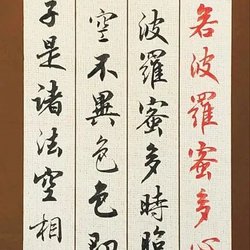Daya, a monk from the Tang Dynasty, and others collected calligraphy and inscriptions written by King Xizhi of the Jin Dynasty. Founded in Chang'an in the ninth year of Kaiyuan (721). This stele is also called "Wu Wen Stele" with inscriptions by Xu Sizhong and others. Therefore, the lower half of the stele still exists, so it is also called "Xingfu Temple Half Stele". It has thirty-five lines, each line has twenty-three, four, or five characters, and is hollow. Three lines are now in the Forest of Steles in Shaanxi Provincial Museum. In the Qing Dynasty, Yang Bin said that there were eighteen authors of the king's books in the Tang Dynasty, and "Holy Teaching" was ranked first, and "Xingfu Temple" was second only to "Holy Teaching". The calligraphy is smooth and the imitation is excellent. It is an important original inscription for studying Wang Xizhi's calligraphy. This stele was unearthed in Xi'an, Shaanxi Province during the Wanli Period. "Mo Lin Kuai Shi" states: "Ji Ren Daya is a monk of Xingfu Temple. It is called "Xingfu Tie" in the old world. Ji Wangzi Gu Du got his spiritual strength, so it is Calligraphers value it." The character "四" in the "Four Prefaces" in the 20th line of the old rubbings is intact, and the character "剧" (jin) in the eight-line "duancai" is intact. Before liberation, the character "四" in the "Four Prefaces" of the old rubbings was found in Mingming Bookstore, Nippon Hakuwendo, Yiyuan Zhendangsha, Ergensha and Nippon "Book Garden" has been photocopied and published.


Collection of Wang Xizhi's "Half Stele of Xingfukuji Temple" Collection of Takashimamoto, Tokyo National Museum, Japan



















